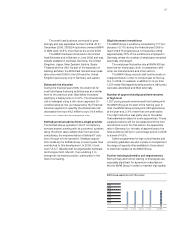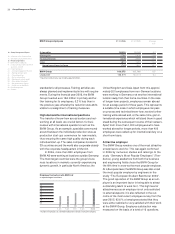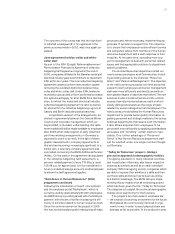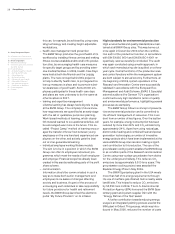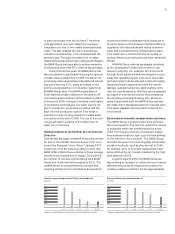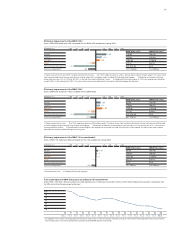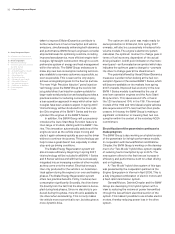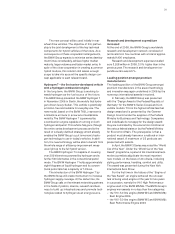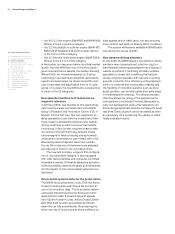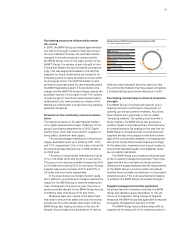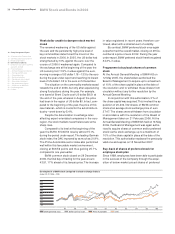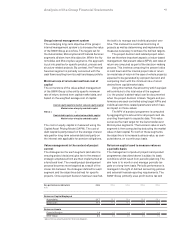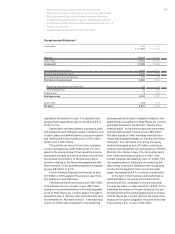BMW 2006 Annual Report Download - page 36
Download and view the complete annual report
Please find page 36 of the 2006 BMW annual report below. You can navigate through the pages in the report by either clicking on the pages listed below, or by using the keyword search tool below to find specific information within the annual report.
35
Purchasing structures influenced by model
life-cycles
In 2006, the BMW Group purchased approximately
one half of its bought-in parts in Germany. Across
the rest of Western Europe, the purchase volume
changed in line with production volumes within
the BMW Group. Due to the sales growth of the
BMW 3 Series, the volume of parts bought in from
Central and Eastern Europe increased correspond-
ingly. This was largely attributable to the fact that
suppliers for these model series are located to an
increasing extent in newly acceded countries within
the European Union. The NAFTA market is used
primarily to purchase parts for cars manufactured at
the BMW Spartanburg plant. The production line
change and the BMW X5 model change caused the
purchase volume in this region to fall. The volume
of parts bought in from South America was mainly
attributable to the lower production volume of the
MINI at the Oxford plant, brought about by capacity
expansion measures.
Situation on the commodity markets remains
tense
The high price levels on the raw material markets
once again represented a major challenge for the
group’s purchasing departments in 2006. Signifi-
cantly higher costs had to be paid for supplies of
steel, plastic, aluminium and copper.
The annual average market price of aluminium,
copper and plastic went up in 2006 by 34%, 76 %
and 13 % respectively. Only in the case of steel did
the annual average market price in 2006 remain at
its 2005 level.
The price of industrial raw materials went up by
31% in US dollar terms and by 30 % in euro terms.
The price of non-precious metals increased by 56%
in US dollar terms and by 55% in euro terms. Energy
supplies saw a price increase of 21% and 22% in
US dollar and euro terms respectively.
In the case of precious metals (rhodium, palla-
dium, platinum), purchase price hedges reduced the
impact for the BMW Group of extreme market price
rises. Compared to the previous year, the price of
precious metals relevant for the BMW Group went up
in 2006 by rates of between 27% and 116 %.
Measures were put in place in the area of raw
materials to ensure that additional costs were fairly
spread over the entire added-value chain, with the
BMW Group also bearing its share of the cost.
Al-
though the purchase price predictions of various
institutes have indicated, since the year-end, that
the commodity markets may have eased somewhat,
it is likely that high price levels will persist in 2007.
Purchasing centres help to enhance innovative
strength
The BMW Group’s international network of pur-
chasing centres is committed to the process of
opening up new procurement markets. Focus has
been sharpened in particular on the so-called
“emerging markets”. By realising cost benefits in
these markets, the BMW Group can generate a
positive impact on purchase prices, thus improving
its competitiveness. By analogy to the way that the
BMW Group’s competitiveness is being improved,
suppliers are also encouraged to take better advan-
tage of the cost benefits available on emerging
mar-
kets and to modify their process chains accordingly.
At the same time, measures must be put in place to
ensure that stipulated quality and availability levels
are constantly maintained.
The BMW Group’s purchasing centres are part
of the innovation management process.They inves-
tigate whether the innovative technical solutions
offered by the supply markets meet the requirements
of the BMW Group’s product profile and assess
whether they can make a contribution to the product
creation process. This is an essential factor helping
to enhance the BMW Group’s innovative strength.
Supplier management further optimised
As a manufacturer of premium vehicles, the BMW
Group also attaches great importance to the effi-
ciency of its suppliers. Using a range of targeted
measures, the BMW Group was again able to improve
its supplier management systems in 2006.
The BMW Group fosters relationships with its
suppliers at an early point in the creative process in
Regional mix of BMW Group purchase volumes 2006
in %, basis: production material
Germany
Rest of Western Europe
Central and Eastern Europe
NAFTA
Africa
Asia/Australia
South America 9
10
3
1
3
20
54


